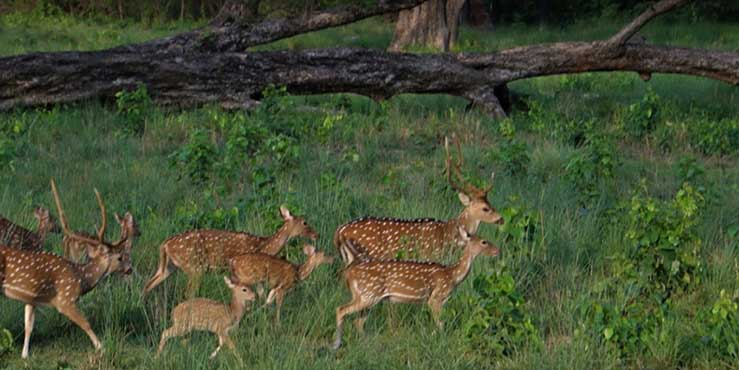Introduction
The birthplace of Lord Buddha, Nepal is deeply influenced by Buddhist teachings, with many places across the country reflecting its profound significance and spiritual heritage. In Nepal, Buddhism is more than just a religion; it is a way of life that influences daily practices and values.
Around 9% of Nepal's population follow Buddhism, and the country is home to hundreds of Buddhist pilgrimage sites. The history of Buddhism in Nepal traces its origins to Lumbini, the sacred birthplace of Lord Buddha. In Kathmandu, places like Swayambhunath and Boudhanath stand as rich cultural centers, preserving the essence of Buddhist teachings and rituals.
For those seeking to immerse themselves in Nepal’s Buddhist heritage, there are numerous Himalayan treks that offer more than just adventure—they offer tranquility and a deeper connection to the Buddhist way of life. Trekking through the Himalayas brings a sense of peace, as you get up close to the majestic mountains and witness landscapes that will stay with you forever. Nepal is a rich tapestry of sacred Buddhist sites, each providing a distinct spiritual journey. From the serene birthplace of Buddha in Lumbini to the peaceful caves of Pharping where meditation has been practiced for centuries, and the majestic stupas and monasteries that grace the Kathmandu Valley, Nepal offers countless opportunities to connect with the heart of Buddhist teachings. Whether you are embarking on a pilgrimage or simply immersing yourself in the country's rich Buddhist heritage, a visit to Nepal promises an experience that is both profound and transformative.
Highlights
- Gain a deeper understanding of Buddhist teachings and philosophies through visits to sacred sites.
- Experience the historical roots of Buddhism in the land where the Buddha was born.
- Take part in meditation retreats at monasteries like Kopan Monastery and Pharping, where you can learn traditional practices that help cultivate mindfulness, peace, and inner calm.
- Immerse yourself in the rich Buddhist culture of Nepal, where traditions and rituals are an integral part of daily life.
- Spend time in tranquil surroundings, such as the stupas of Swayambhunath or Bauddhanath, where you can escape the hustle and bustle of daily life and achieve a sense of peace and mental clarity.
- Hiking to sites like Namobuddha offers not only physical activity but also an opportunity for reflection and self-discovery.
- Experience the natural beauty of Nepal, including the stunning Himalayan landscapes, which offer a peaceful backdrop for spiritual practice.
- A Buddhist pilgrimage in Nepal can be a transformative journey, allowing for emotional and spiritual healing through the practice of prayer, meditation, and connecting with sacred spaces.
- Learn about the Buddha’s teachings on compassion, mindfulness, and wisdom by engaging with local monks and Buddhist practitioners.
- Explore the legendary stories of Buddha's life at sites like Lumbini, where his path to enlightenment and his teachings on suffering, impermanence, and self-awareness are brought to life.
Buddhist sites around Kathmandu valley
Kathmandu Valley is a renowned destination for Buddhist pilgrims, home to a rich collection of sacred sites that reflect the deep history of Buddhism in Nepal and the wider Himalayan region. With its ancient stupas, revered monasteries, and spiritually significant landmarks, the valley is not only a place of profound devotion but also a center for Buddhist study and practice.
Below are some of the most important Buddhist pilgrimage sites in the Kathmandu Valley :
Swayambhnath Stupa
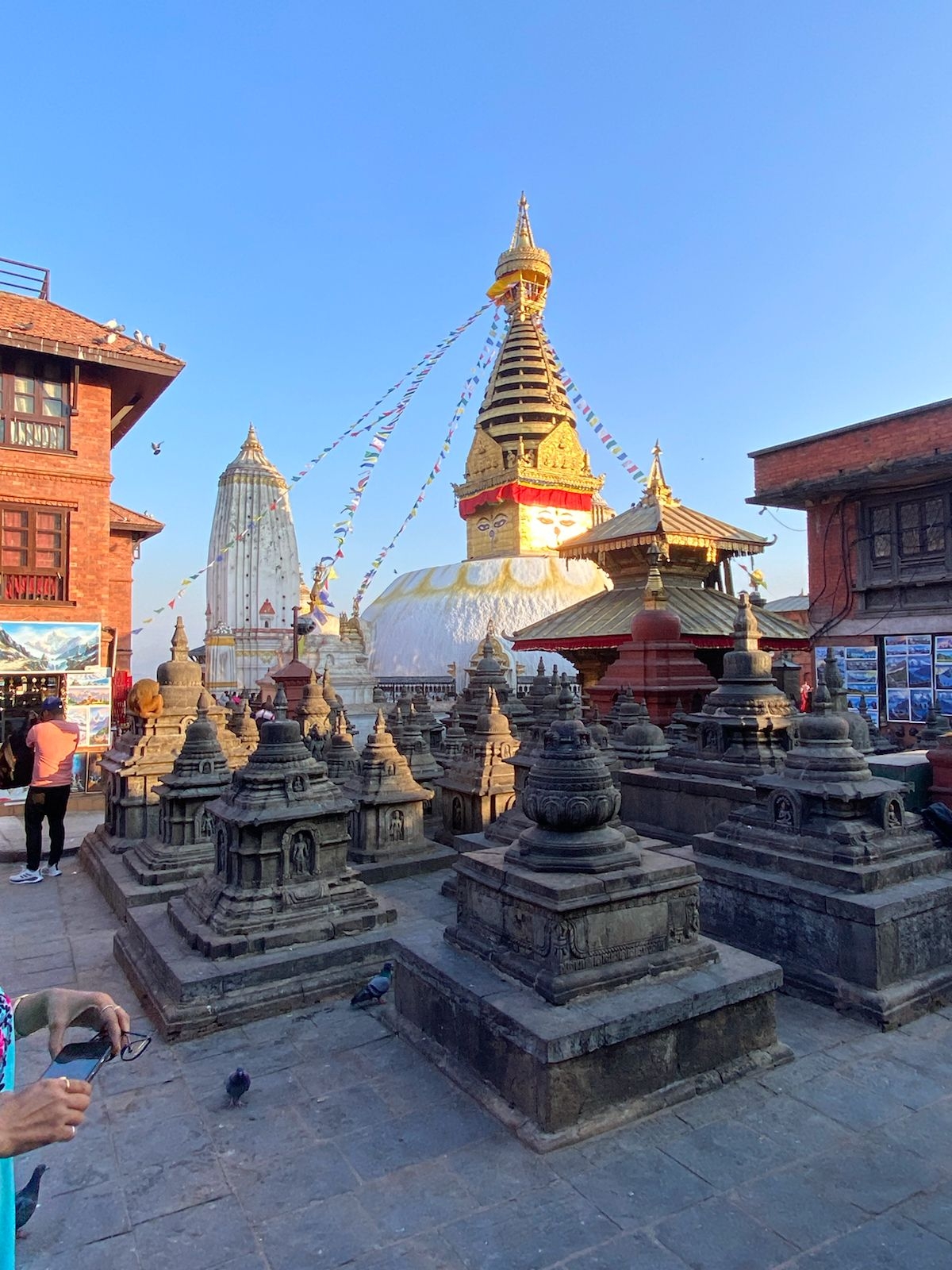
Swayambhunath is one of the seven UNESCO World Heritage Sites in the Kathmandu Valley and stands as one of Nepal's oldest and most revered religious complexes. Also known as Swoyambhu, Swayambhu Maha Chaitya, or the Swayambhu Stupa, this sacred Buddhist stupa is perched atop a hill, offering not only profound spiritual significance but also panoramic views of Kathmandu and the surrounding valley. With its deep historical roots, stunning architecture, and serene surroundings, Swayambhunath continues to be a lasting symbol of Nepal's rich spiritual heritage—a must-visit destination for anyone exploring the heart of Kathmandu.
Namobuddha
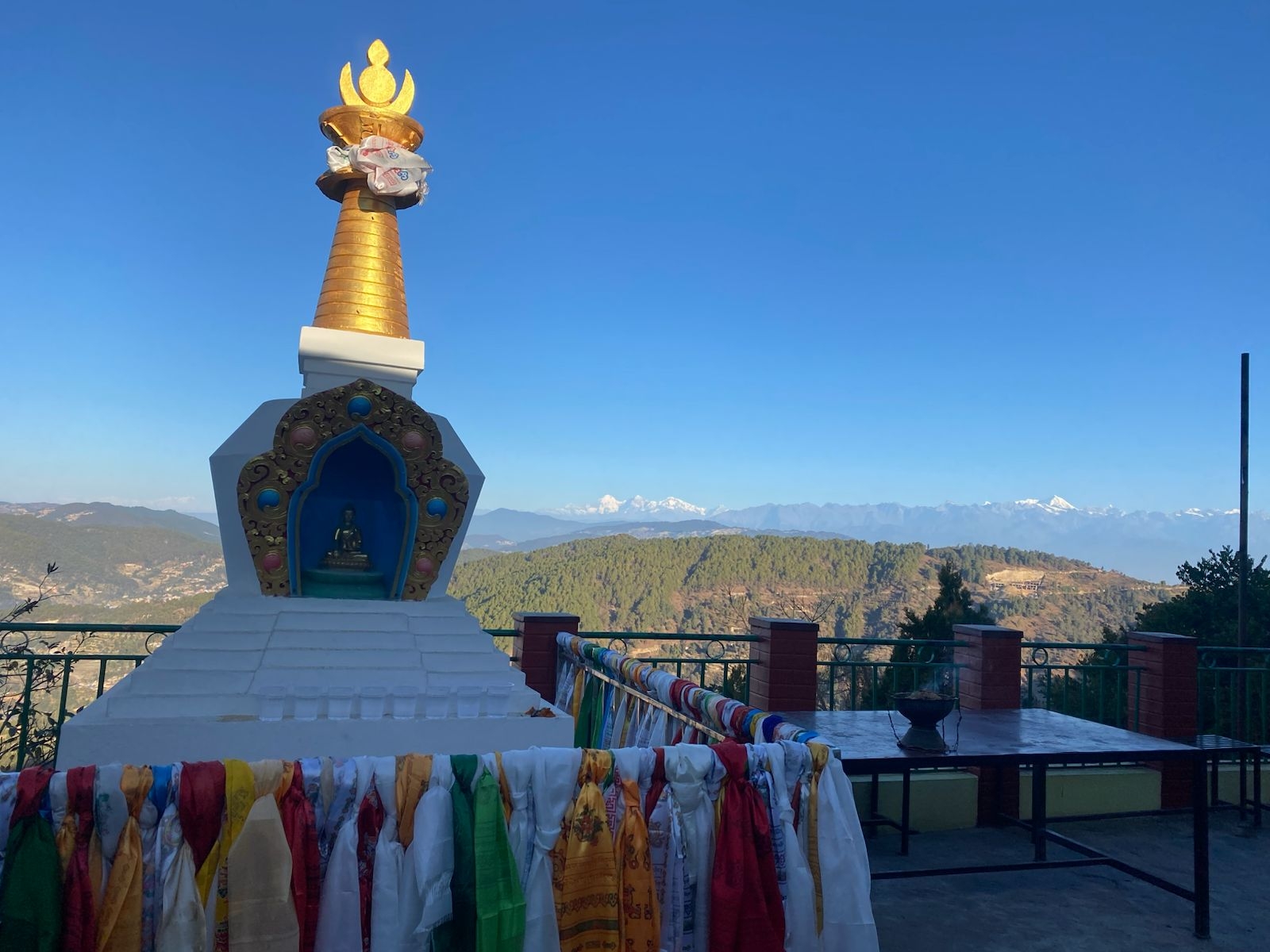
Namobuddha, a sacred Buddhist pilgrimage site, is located in the Kavre district of Nepal, approximately 40 kilometers east of Kathmandu. Known for its immense spiritual significance, it is believed to be the place where the Buddha, in a past life, sacrificed his body to a hungry tigress and her cubs. The site features key structures, including a large stupa, a monastery, and smaller shrines. The stupa, located on a hilltop, offers stunning views of the surrounding countryside, while the Namobuddha Monastery houses hundreds of monks and nuns. Visitors can engage in meditation, attend teachings, and learn about Nepal's Buddhist traditions. The serene environment, combined with the natural beauty of the area, makes Namobuddha a peaceful and spiritually enriching destination.
Kopan Monastery
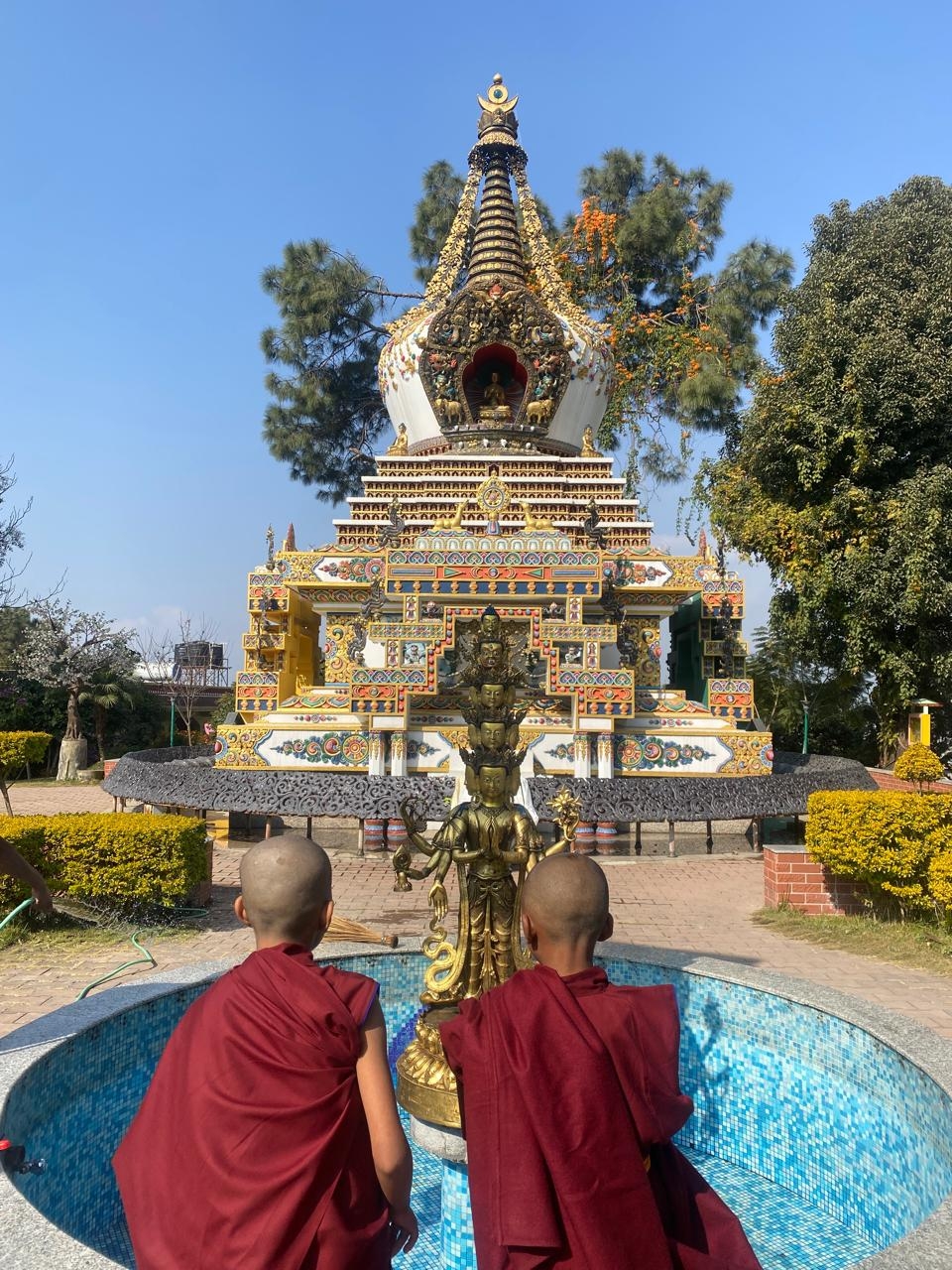
Kopan Monastery is a Tibetan Buddhist monastery located on a hilltop near Kathmandu, Nepal, founded in the early 1970s by Lama Thubten Yeshe and Lama Zopa Rinpoche. It is a major center for Tibetan Buddhism in Nepal, offering a place for students to study Buddhist philosophy and meditate. The monastery complex includes the main building, meditation halls, a large prayer wheel, and beautiful gardens with panoramic views of the Kathmandu Valley. Visitors can participate in meditation sessions, teachings, and retreats. The monastery also features a Thangka painting school, a museum of Tibetan artifacts, and opportunities to enjoy nature through hikes and walks in the surrounding hills and forests.
Asura and Yanglesho caves
Pharping, located 21 kilometers south of Kathmandu, is a spiritually significant site, especially the area of Yangleshö, where Guru Padmasambhava is believed to have reached the level of Mahamudra Vidyadhara. This vibrant Newar town is home to two key caves associated with Guru Padmasambhava's meditation: Asura Cave (the "Upper Cave of Yangleshö") and the Lower Cave of Yangleshö, both of which are considered sacred, particularly for Vajrayana practitioners. Yangleshö holds a place of equal spiritual importance as Bodhgaya.
Sankhu Vajrayogini and Milarepa cave Pharping has also been visited by other renowned spiritual figures, including Marpa Lotsawa, who practiced, made offerings, and enriched the spiritual history of the area.
Sankhu Vajrayogini and Milarepa cave
Sankhu, a historic Newar town in the northeastern Kathmandu Valley, is renowned for its spiritual significance, particularly the Vajrayogini Temple and its ancient meditation caves, which are considered sacred sites in Vajrayana Buddhism. The caves, believed to be older than the temple, were used by ancient practitioners and are associated with Milarepa, the famous Tibetan yogi. The 17th-century Vajrayogini Temple is dedicated to Vajrayogini, a powerful deity in Vajrayana, and houses an image of Ugra Tara, a fierce protector deity central to the Nyingma school. Sankhu continues to be an important center for meditation, tantric rituals, and Dharma protection, attracting both local Newars and Tibetan Buddhists, while preserving its rich cultural and spiritual heritage.
Boudhanath Stupa
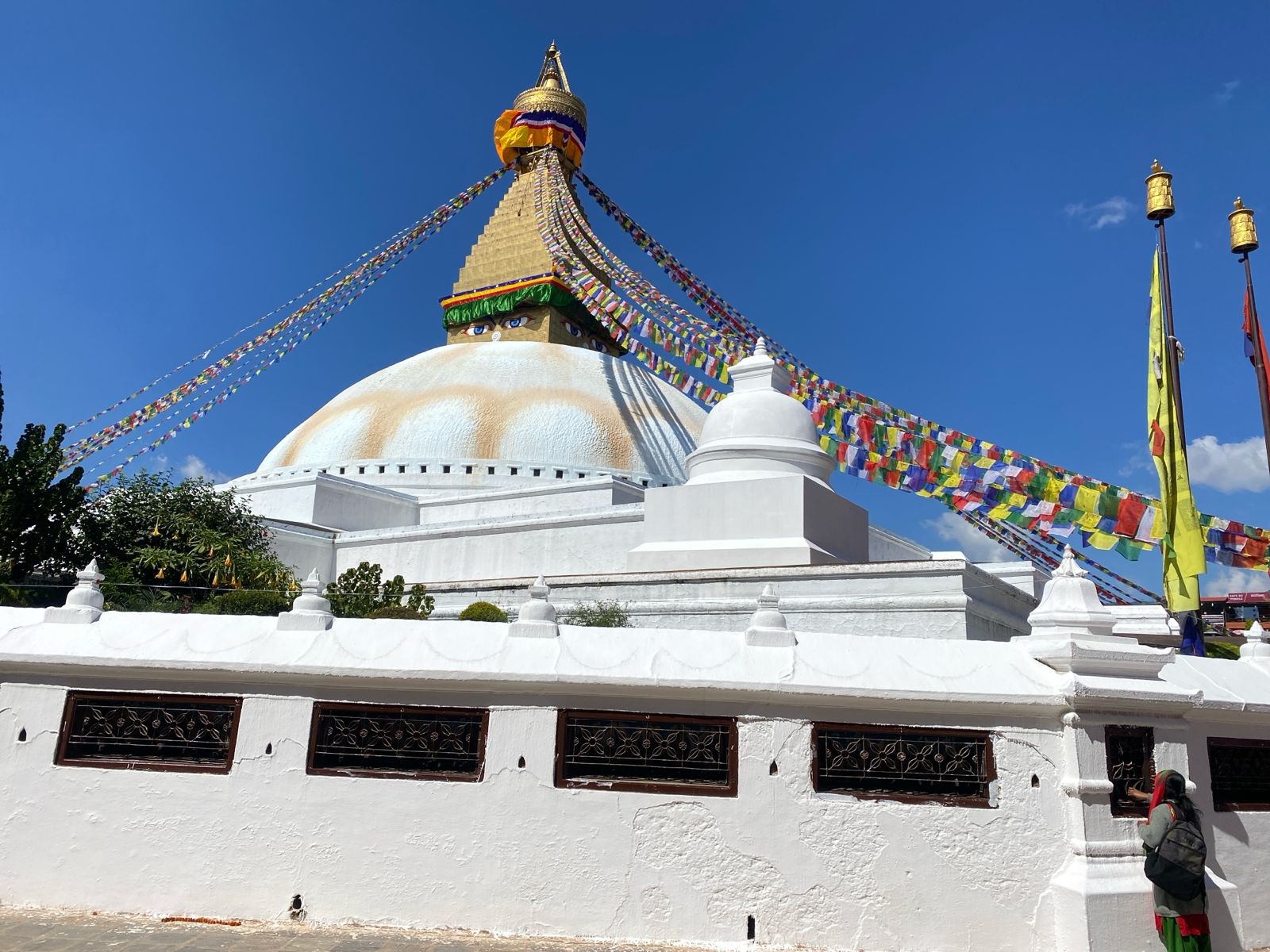
Boudhanath Stupa is situated in eastern Kathmandu, is one of the largest and most important stupas globally, as well as a UNESCO World Heritage site. Built over 1,500 years ago by King Shiva Dev, it stands over 36 meters tall and is a major center of Tibetan Buddhism in Nepal, housing relics of the Buddha. The stupa is surrounded by a lively market with monasteries, shops, and restaurants, and pilgrims frequently turn the prayer wheels that encircle it. Notable nearby attractions include the Shechen Monastery, founded by Dilgo Khyentse Rinpoche, and the Kopan Monastery, which offers stunning views of the Kathmandu Valley. Boudhanath remains an important spiritual and cultural hub, drawing visitors from around the world.
Four Ashokan Stupas of Patan
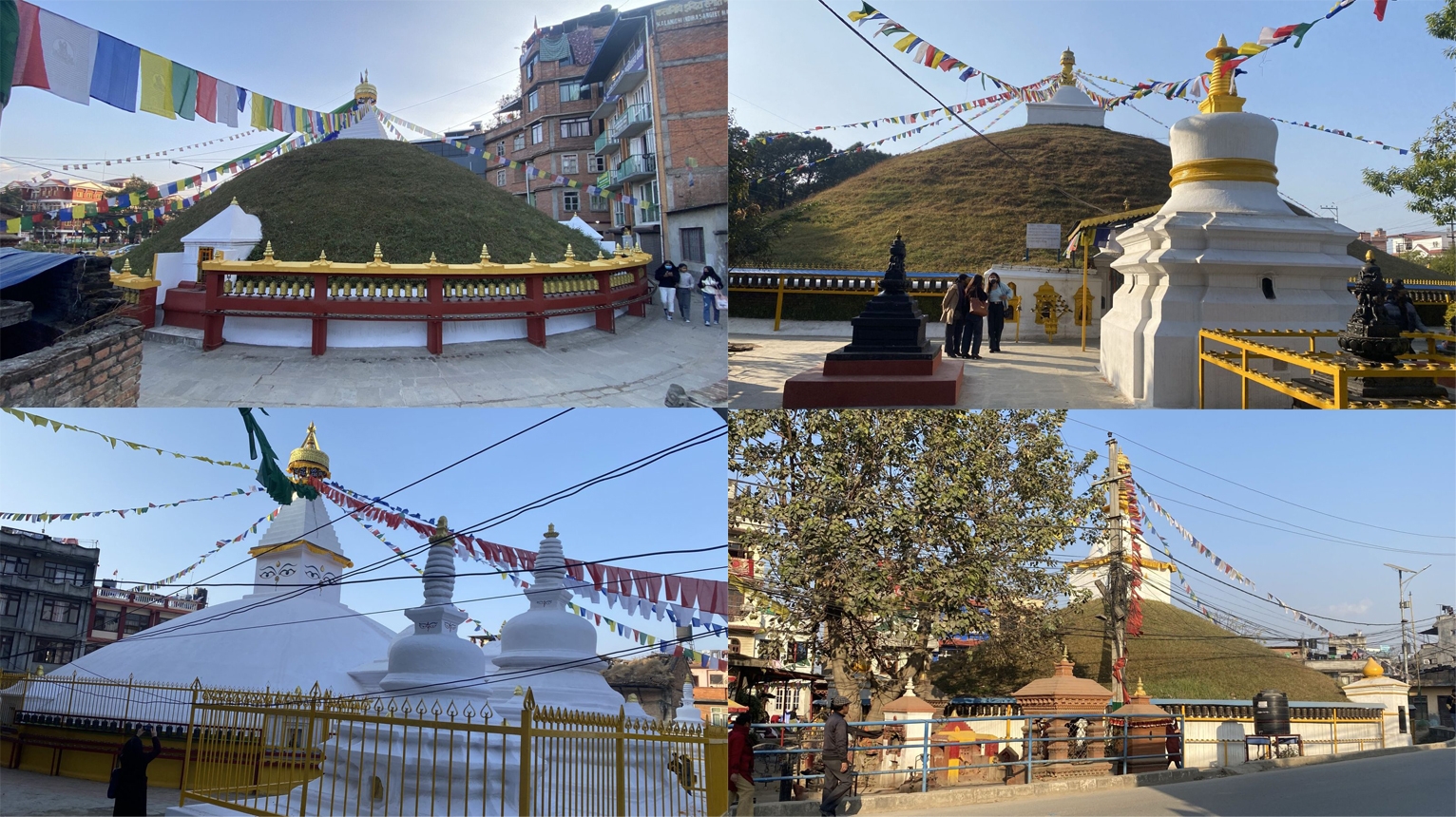
The four Ashoka stupas in Patan stand as enduring symbols of the region's deep cultural legacy and spiritual history. It is believed that Emperor Ashoka, a key figure in the spread of Buddhism across Asia, visited the Kathmandu Valley in the 3rd century BCE. During his visit, he is said to have constructed these stupas at the four cardinal points of Patan.
Guheshwori
Newar Buddhists consider Guhyeshwari sacred to Vajrayogini in her form as Vajravarahi, believing it to be the site of the mythical lotus root upon which the Swayambhunath Stupa rests. This lotus is also thought to symbolize the umbilical cord that nourishes Kathmandu. In Tibetan, the site is known as Pakmo Ngülchu (Womb Fluid of Varahi). The water from the temple well, which flows from a nearby spring, is believed to represent vaginal blood, or possibly amniotic fluid, and is thought to be the sacred wash of Vajravarahi.
Famous buddhist pilgrimage sites in Nepal
Nepal is renowned for its rich Buddhist heritage, housing several significant pilgrimage sites that hold immense historical, spiritual, and cultural value. These sacred locations attract thousands of Buddhists and spiritual seekers from across the globe, especially followers of Vajrayana Buddhism and the Mahayana tradition. Below are the top 5 Buddhist pilgrimage sites in Nepal :
Lumbini
Lumbini, located in the Terai region of Nepal, is the birthplace of Lord Buddha and one of the most important pilgrimage sites in Buddhism. It is one of the four major holy places of Buddhism, alongside Bodh Gaya, Sarnath, and Kushinagar, and has been a UNESCO World Heritage Site since 1997. Lumbini holds deep religious significance as the site where Queen Maya Devi gave birth to Prince Siddhartha Gautama (the Buddha) in 623 BCE. The Maya Devi Temple, marking the exact spot of Buddha’s birth, is one of the key attractions, along with various monasteries, stupas, museums, and gardens that reflect the diversity of Buddhist traditions worldwide.
Halesi Maratika Cave
Halesi Maratika Cave, located in eastern Nepal, is a revered Buddhist site of profound spiritual significance, especially for followers of the Nyingma school of Tibetan Buddhism. It is believed to be the sacred spot where Padmasambhava, the founder of the Nyingma tradition, attained enlightenment. The cave, with a history spanning thousands of years, was first discovered by the Hindu sage Maratika, who meditated there and is believed to have attained enlightenment. Later, Padmasambhava is believed to have visited the cave, further cementing its importance as a Buddhist pilgrimage site.
Set atop a hill, the cave is surrounded by lush forests and breathtaking mountain vistas, creating a serene and powerful spiritual atmosphere. Pilgrims from all over the world visit Halesi Maratika Cave to meditate, pray, and experience its transformative energy. Known for its deep spiritual resonance, the site offers not only a connection to ancient religious traditions but also a peaceful retreat for those seeking inner peace and enlightenment.
Ramgram Stupa
The Ramgram Stupa, situated in the Nawalparasi district of Nepal, is an important Buddhist pilgrimage site and one of the eight great stupas in Buddhist tradition. Believed to be over 2,500 years old, it houses a relic of the Buddha, specifically a portion of his cremated remains. The stupa is situated on a grassy mound and is preserved in its original state, with access restricted to maintain its purity. The relic is displayed only during special occasions like the annual Ramgram festival, held on the full moon day of Magh (January/February), which attracts thousands of pilgrims from around the world. The site is maintained by the Lumbini Trust Development and holds immense historical and spiritual importance for Buddhists.
Tilaurakot
Tilaurakot, located in the Kapilvastu district of Nepal, is a key archaeological site believed to be the birthplace of Siddhartha Gautama, the Buddha. Formerly the capital of the Shakya kingdom, it is now regarded as one of Nepal's most significant Buddhist pilgrimage destinations. The site features the ruins of a fortified city, including palaces, temples, and other structures, surrounded by a moat and walls. Notable attractions include the remains of the Buddha's birthplace and other historical buildings. The nearby Tilaurakot Museum displays artifacts such as sculptures, pottery, and coins, providing insight into the culture and daily life of the ancient Shakya people.
The World Peace Pagoda
The World Peace Pagoda, also known as the Shanti Stupa, is a Buddhist monument located in Pokhara, Nepal. Built in the early 1970s by peace advocate Nichidatsu Fujii, the pagoda stands as a symbol of global peace, unity, and interfaith harmony. Its striking white façade is crowned with a golden spire and adorned with detailed carvings and vibrant paintings that illustrate Buddhist teachings. Set amidst a tranquil garden, the pagoda offers stunning panoramic views of the Annapurna mountain range and Phewa Lake. Visitors are invited to explore the site, participate in meditation, and immerse themselves in both the spiritual atmosphere and the natural beauty of the surrounding landscape.
Buddhist Pilgrimage Sites in Nepal for Trekkers
Nepal is renowned not only for its stunning mountain treks but also for its deep spiritual heritage, with many Buddhist pilgrimage sites spread throughout the country. For trekkers seeking to experience both the beauty of nature and the significance of spirituality, these sites provide a unique blend of adventure and devotion. Here are some of the most notable Buddhist pilgrimage destinations in Nepal for trekkers:
Gosainkunda
Gosaikunda Lake, located at 4,380 meters in Nepal, is a sacred site for both Shamanism and Buddhism, surrounded by towering mountains. It attracts thousands of Hindu pilgrims annually during Janai Purnima (the full moon in August) for blessings. A rock in the lake’s center is believed to be the head of Lord Shiva. The site is also significant for Shamans, or Bon-Po, a pre-Buddhist sect. On full moon night, Shamans gather at Gosaikunda to perform spiritual dances and chants, marking a rite of passage for apprentices who graduate under senior Shamans, strengthening the lake's spiritual and cultural significance.
Milarepa Cave
Milarepa Cave, situated at an altitude of 4,100 meters in Nepal's Langtang Region, is a sacred site in Tibetan Buddhism. It is believed to be where the famous Tibetan saint Milarepa meditated and achieved enlightenment in the 11th century. The cave, which contains a stone platform, a small stupa, and prayer flags, is a place of deep spiritual significance for both pilgrims and meditators. The surrounding area, within Langtang National Park, is renowned for its breathtaking natural beauty, diverse wildlife—such as the endangered red panda and snow leopard—and spectacular mountain vistas, making it a sought-after destination for both trekkers and spiritual seekers.
Muktinath Temple
Muktinath Temple, located at 3,710 meters in Nepal's Mustang district, is a revered pilgrimage site for both Hindus and Buddhists, believed to offer liberation from the cycle of life and death. Dedicated to Lord Vishnu and founded by the Buddhist monk Naropa in the 8th century, the temple features a statue of Vishnu alongside Avalokitesvara. The site also includes healing natural springs and offers stunning views of the Himalayas and Kali Gandaki River. Pilgrims perform rituals like bathing in the sacred springs and praying at the temple, while nearby attractions such as the Jwalamai Temple, with its eternal flame, further enhance the area's spiritual significance and natural beauty.
Tengboche Monastery
Tengboche Monastery, situated at 3,867 meters in Nepal's Khumbu region, is a prominent Tibetan Buddhist monastery offering spectacular views of the Himalayas, including Mount Everest. Established in the early 20th century by Lama Ngawang Tenzin Norbu, it was destroyed in a 1934 earthquake and rebuilt in the 1960s. The monastery is renowned for its distinctive architecture, featuring a spacious prayer hall adorned with detailed murals, intricate wood carvings, and a statue of Buddha. It houses a community of monks who engage in daily rituals, chanting, and meditation. The monastery is famous for hosting the annual Mani Rimdu festival in the autumn, which attracts pilgrims from Nepal and Tibet for traditional music, dance, and religious ceremonies. A popular stop for trekkers, it serves as both a spiritual retreat and a cultural landmark, offering breathtaking mountain vistas and opportunities for reflection and photography.
Shey Gompa
Shey Gompa, also known as Shey Monastery or the Crystal Monastery, is a remote Tibetan Buddhist site located at an altitude of 4,160 meters in Shey Phoksundo National Park, Nepal’s Dolpo region. Founded in the 11th century by Tibetan saint Rinchen Zangpo, it is deeply connected to Guru Rinpoche, who is said to have meditated in the nearby caves. The monastery features a prayer hall adorned with intricate wood carvings, murals, and a statue of Guru Rinpoche. It is home to a community of monks who engage in daily spiritual practices. Every summer, the Shey Festival attracts pilgrims from Nepal and Tibet, showcasing traditional music, dance, and religious rituals. Additionally, the picturesque Shey Phoksundo Lake, renowned for its natural beauty, draws trekkers and hikers from around the world.
Conclusion
Nepal is a land of profound spiritual significance, where the legacy of Buddhism is deeply woven into its cultural and historical fabric. As the birthplace of Siddhartha Gautama (Buddha), Nepal is home to some of the most sacred and revered Buddhist sites in the world.For those seeking a deeper understanding of Buddhist philosophy, Nepal provides an invaluable connection to the roots of the religion. Whether you are a devout Buddhist, a spiritual seeker, or a cultural enthusiast, Nepal’s Buddhist sites offer a transformative experience that goes beyond sightseeing—they invite you to reflect on the universal teachings of peace, mindfulness, and compassion.
Nature Trail has been organizing Buddhist tour packages in a seamless and efficient manner.
In sum, the Buddhist sites of Nepal are not just destinations—they are living symbols of a rich spiritual tradition that continues to inspire millions around the world. Visiting these sacred locations offers a unique opportunity to explore the heart of Buddhism and to connect with a timeless tradition that continues to shape the lives of people around the globe.









